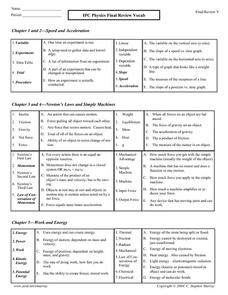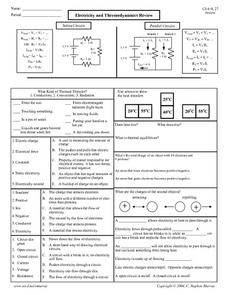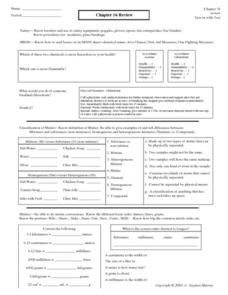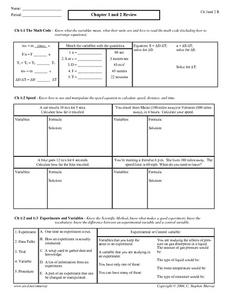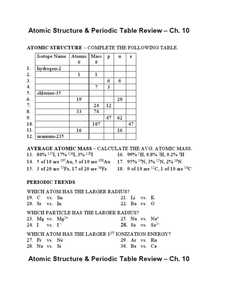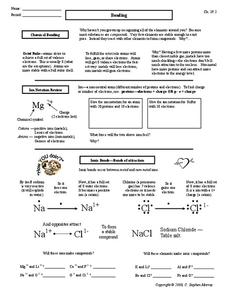Curated OER
IPC Review
Students discuss the difference between atoms and elements. They analyze how compounds are formed. Students discuss the difference between covalent bonds, hydrogen bonds, and ionic bonds. They review bonding with diagrams, "Atoms or...
Curated OER
IPC Chemistry Review
In this chemistry review worksheet, learners classify and name compounds, calculate atomic mass, draw Lewis Dot Diagrams, and determine number of protons for atoms. This worksheet has 37 fill in the blank, 38 matching, and 3 short answer...
Curated OER
IPC Physics Final Review
In this physics review worksheet, students compare experimental variable, simple machines, and Newton's Laws. Students calculate kinetic energy, work, power, speed, and velocity. Students review conduction, convection, and radiation....
Curated OER
IPC Physics Vocabulary Review
In this physics review worksheet, students review vocabulary words associated with speed, acceleration, Newton's Laws and simple machines, work and energy, magnetism, electricity, and harmonic motion and light. This worksheet has 92...
Curated OER
IPC Physics
For this physics review worksheet, students compare inertia and momentum, insulators and conductors, and series and parallel circuits. Students review Newton's laws. This worksheet has 20 fill in the blank, 12 matching, and 20 problems...
Curated OER
Electricity and Thermodynamics Review
In this electricity and thermodynamics worksheet, high schoolers review the major concepts of both series circuits and parallel circuits, they review types of thermal transfer, they match electricity terms with their definitions, they...
Curated OER
Density Review
In this density worksheet, students review how to calculate density and how to apply Archimedes' Principle, Boyle's Law, and Charles' Law. This worksheet has 10 matching, 13 short answer, and 6 fill in the blank questions.
Curated OER
Atom Review
In this atom worksheet, students review the subatomic particles, the scientists associated with the atomic theory, and the periodic table. This worksheet has 15 matching, 24 fill in the blank, and 11 short answer questions.
Curated OER
Harmonic Motion and Light Review
In this harmonic motion and light worksheet, students review concepts such as identifying motion as harmonic, linear or wave motion, analyzing graphs of position vs. time and pendulum movement, answering questions about light and the...
Curated OER
Chapter 16 Review- General Science
In this review of general science activity, students classify examples of matter as mixtures or substances, homogeneous or heterogeneous mixtures, or elements or compounds. Students also convert several examples using the standard units...
Curated OER
Chapter 22 - 25 Review
In this chemistry review worksheet, students explore their knowledge of solutions, acid and bases, nuclear reactions, and radioactive decay as they answer 33 matching, fill in the blank, and short answer questions.
Curated OER
Chapter 3 and 4 Review
In this physics review instructional activity, students complete 42 matching, fill in blank, and problem solving questions pertaining to Newton's laws, force formulas, distance formulas, and simple machines.
Curated OER
Chapter 1 and 2 Review
In this physics review worksheet, students complete 24 matching and problem solving questions pertaining to math code, speed, experiments and variables, slope, and acceleration and average speed.
Curated OER
Nomenclature Review
In this nomenclature instructional activity, students are given the formulas for ionic compounds, molecular compounds and inorganic acids and they write their names. They also write the formulas given the names of ionic compounds,...
Curated OER
Nature of Science and Measurement Review
For this nature of science and measurement worksheet, students answer 30 questions about experimental design, pure science vs. applied science, density, metric conversions and dimensional analysis.
Curated OER
Newton's Laws Review
In this Newton's Laws worksheet, students solve 4 problems using Newton's Laws. Students explain their work and calculations using Newton's Laws and equations.
Curated OER
Atomic Structure and Periodic Table Review
For this atomic structure and periodic table worksheet, high schoolers complete a table with isotopes, their atomic masses, the number of protons, neutrons and electrons and mass number. They also find the average atomic mass of atoms...
Curated OER
Archimedes' Principle
In this Archimedes' principle worksheet, students answer 13 questions about the concepts of Archimedes' principle such as water displacement, buoyancy and force. The answer questions from a lab they did in class to simulate Archimedes'...
Curated OER
Chemical Reactions
In this chemical reactions activity, students compare endothermic and exothermic reactions, closed and open systems, and reactants and products. Students review physical and chemical changes and how to balance equations. This activity...
Curated OER
Periodic Table
In this periodic table and elements learning exercise, learners review valence electrons, octet rule, oxidation number, and the difference between metals and non-metals on the periodic table. This learning exercise has 5 matching, 20...
Curated OER
Basics of Science
In this basics of science worksheet, students review the metric system, the difference between homogenous and heterogenous mixtures, the scientific method, and science lab first aid. This worksheet has 15 short answer, 43 fill in the...
Curated OER
Magnetic Induction
In this electricity instructional activity, students learn about magnetic induction plus compare a generator with a motor. Students also review the different kinds of energy and the formulas associated with energy. This instructional...
Curated OER
Bonding
In this bonding worksheet, students read about the two different types of chemical bonding: ionic and covalent bonds. Students review ion notation and oxidation numbers. This worksheet has 24 fill in the blank, 2 drawings, and 4 short...
Curated OER
More Chemical Bonding
In this chemical bonding learning exercise, students review the three types of compounds: ionic, covalent, and polyatomic. Students practice drawing the covalent bonds of given compounds. This learning exercise has 5 drawings and 13 fill...



